NEWS
The key to on-demand printing: post-press concepts and technological innovation
CTP plate making technology and digital printing machine are the result of computer technology penetration printing industry. Efficient omni-directional scanning technology that instantly converts originals into plates. It also has the advantages of outlet expansion control, consistency of dot density on the whole plate, elimination of human factors caused by manual operations, short printing preparation time, and convenient transmission and storage. The digital press under the control of the same program can work quickly as required. Printing that allows on-demand printing of plates and plates (or plate cylinders) to the substrate is achieved. The problem lies in the post-press processing that remains the same.
Post-press processing is divided into two parts: print surface finishing and finishing and print sorting.

As a finishing technology for finishing finishing, there are coatings (bright, matte), glazing (whole or partial, bright or matte), die cutting, indentation, and anodized aluminum stamping.
As a molding technology for the classification and binding of printed matter, there are books, magazines, saddle stitching, wireless binding, and fine binding. There are also packaging and box substrate reinforcement (overlay corrugated paper, honeycomb paper, board paper, moisture proof, oil proof). , protection from light, barrier materials) and bonding.
Coating and glazing are the conventional techniques for finishing finishing of the finishing surface. The process is based on random coating of adhesives, instant coating of glazing coatings or glazing. It is easy to produce pollution caused by volatilization of organic solvents during production, and the resulting health damage and sudden fires of production personnel. The products produced often have new quality problems such as incompatibility, color change, and odor migration.
Low-quality flat-booking technology continues to be adopted in underdeveloped countries. The introduced perfect binding equipment is not working properly in these areas. Not only does it cause a lot of investment waste, but the bound books also have problems such as bulk falling, falling pages, and being difficult to read.
Both of these post-printing contents are operated outside the printing production line and are inefficient. The traditional concept and technology of labor-intensive and extensive type form an obstruction embolism in the whole process of printing. In the direction of digitization, the backwardness and gap between the post-press is more obvious.
Breaking through the constraints of post-press concepts and technology, the rapid development of post-printing in accordance with digital printing and market requirements can complete the 21st century printing process. The key to achieving on-demand printing is that post-press technology must be innovative.
Postpress processing is controlled by a computer. Implementation of CIP3 (prepress, printing, postpress processing) integrated industrial standards for pre-press, printing and post-press comprehensive utilization. Uniform standards must be implemented with prepress and print production process systems to be networked into a fully digital production process system. Develop software and interfaces that control the entire production process in a digital way. The database will be connected to a management information system that provides job scheduling, tracking, and work instructions. To ensure that the entire workflow (from color separation to post-press processing) operates in a predictable or dependent manner of quality.
According to the instructions entered before the printing, the surface finishing can be processed at the specified part. The digital laminating process enters a new process of hot pressing compound production without glue application. It is a solid phase glazing green product that can be decomposed and decomposed under new specific conditions. Data-controlled new glazing process such as on-line printing or spraying, and new drying techniques such as electron beam and microwave, make the glazing coating reach a thickness with sufficient strength without any negative influence, and become a liquid film. While further improving the surface state of the paper, the paper is compensated for defects such as tear resistance, water resistance and oil resistance. The new polymer reactive and biopolymerized binder hot melt adhesives will replace conventional binder materials that are aging and inconvenient to recycle.
Post-press technology innovation is more important in the transformation of ideas. Seeking truth from facts, knowing the facts, people-oriented, and serving the market are the basic ideas of post-press processing. Not only must the substrate, raw materials, equipment, climate, mood and other variables be monitored as conditions to ensure print quality, but more importantly, it must be known to serve different target groups and produce personalized products made by users.
- After:No
